Bus fleet
Current fleet
Solaris Urbino12
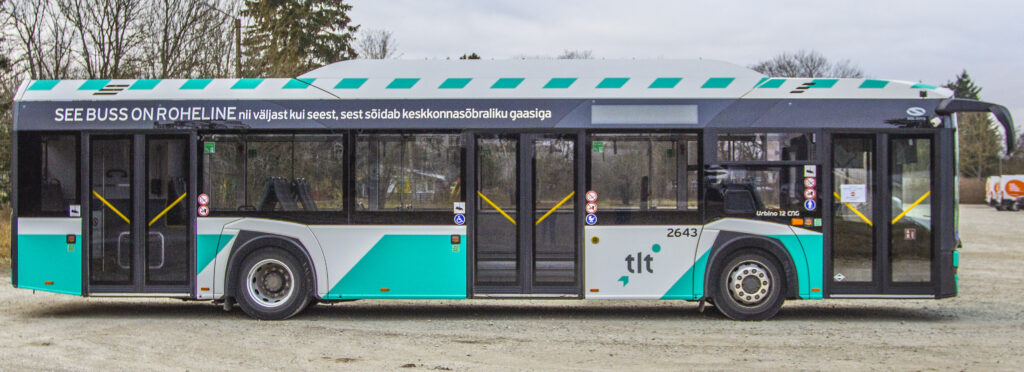
The low-floor Solaris Urbino12 articulated bus is 12 meters long, 2.55 meters wide, and 3.25 meters high. The bus has 31 seats and 49 standing places. The bus is equipped with a 320hp or 239kW methane-based environmentally friendly engine with an emission standard of EURO 6. There are gas cylinders on the roof with a weatherproof cover. The buses have a VOITH Diwa 6 automatic transmission with an integrated retarder.
Solaris Urbino12 buses have double-glazed windows, a roof hatch, and one opening window on each side. The lounges are equipped with a ventilation and heating system. For more convenient passenger service, the buses are equipped with a side tilt function and a mechanically opening wheelchair ramp. The buses have an integrated passenger counting system, information, audio, a priority system, and USB connectors at the seat pairs integrated into the single information system. The material of the seat covers is a modern, well-maintained leather imitation fabric. They started driving in Tallinn in 2020.
Solaris Urbino18

The low-floor Solaris Urbino18 articulated bus is 18 meters long, 2.55 meters wide, and 3.25 meters high. The bus has 41 seats and 106 standing places. The bus is equipped with a 320hp or 239kW methane-based environmentally friendly engine with an emission standard of EURO 6. There are gas cylinders on the roof with a weatherproof cover. The buses have a VOITH Diwa 6 automatic transmission with an integrated retarder.m
For convenient passenger service, the buses are equipped with a side tilt function and a mechanically open wheelchair ramp. The buses have an integrated passenger counting system, information, audio, and a priority system and USB connectors at the seat pairs integrated into the single information system. The buses have double-glazed windows, a roof hatch, and two opening windows on each side, and the lounges are equipped with a ventilation and heating system. There are rails at the top of the lounge for information and advertising, which ensure a free view from the windows. They started driving in Tallinn in 2020.
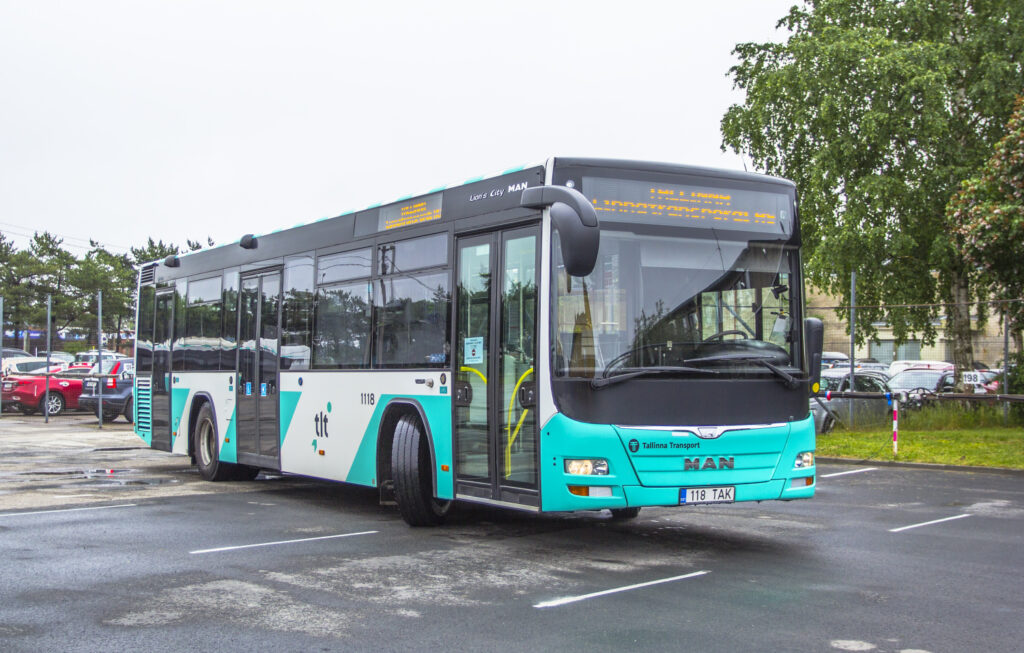
MAN Lion’s City A78
A low-floor city bus with a length of 12 metres, a width of 2.5 metres, and a height of 2.98 metres. Features 30 seats and standing room for 55 passengers. This environmentally friendly bus is fitted with a 213 kW or 285-horsepower diesel engine conforming to the EURO V emissions standard as well as the stringent EEV (Enhanced Environmentally Friendly Vehicle) standard. Compliance with EEV standards is achieved through mechanical means.
The vehicle is equipped with a six-speed ZF Ecolife automatic transmission with integrated retarder, double-glazed windows, and a passenger compartment heating and ventilation system designed for the climate of the Nordic countries. It also has a ‘kneeling’ function and is fitted with a retractable metal ramp for wheelchair access. Introduced to Tallinn in 2013.
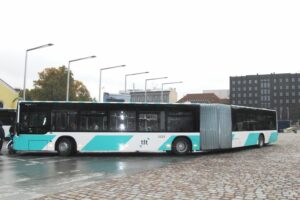
MAN Lion’s City GL/A40 articulated bus
The MAN Lion’s City GL/A40 is a city bus with a length of 18.75 metres, a width of 2.5 metres, and a height of 2.98 metres. It can carry up to 166 passengers with its 44 seats and standing room for 122 people. This environmentally friendly bus is fitted with a 235 kW or 320-horsepower diesel engine conforming to the EURO V emissions standard as well as the stringent EEV (Enhanced Environmentally Friendly Vehicle) standard. Compliance with EEV standards is achieved through mechanical means without AdBlue® fuel additives. This was the first range of EURO V compliant articulated buses adopted in Tallinn. The vehicle is equipped with a six-speed ZF Ecolife automatic transmission with integrated retarder, double-glazed windows, and an efficient passenger compartment heating and ventilation system designed for the climate of the Nordic countries. It also has a ‘kneeling’ function and is fitted with a retractable metal ramp for wheelchair access. Introduced to Tallinn in 2013.
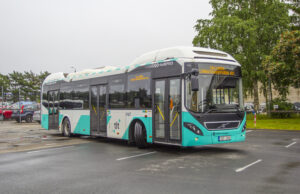
Volvo 7900 Hybrid
A low-floor city bus with a length of 12 metres, a width of 2.55 metres, and a height of 3.27 metres. Features 35 seats and standing room for 50 passengers. This environmentally friendly bus is fitted with a 177 kW or 237-horsepower diesel engine combined with an electric motor whose batteries are charged during travel, which reduces fuel consumption by up to 30% and minimises air pollution. The vehicle is equipped with a six-speed automatic transmission with integrated retarder, double-glazed windows, and a passenger compartment heating and ventilation system designed for the climate of the Nordic countries. It also has a ‘kneeling’ function and is fitted with a retractable metal ramp for wheelchair access. This range of hybrid buses was introduced to Tallinn in 2015.
History
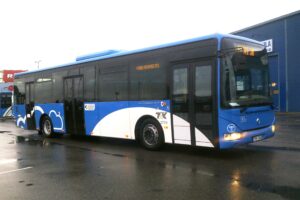
Iveco Irisbus Crossway LE SFR 161/01
On 31 May 2011, the Estonian Road Administration entered into an agreement with the Czech company Iveco Czech Republic a. s. for the purchase of 110 Iveco Irisbus Crossway buses for Estonia, which was financed from the proceeds of an assigned amount unit purchase agreement between the Republic of Estonia and the Kingdom of Spain.
The Road Administration thereby implemented a green investment scheme for the development of public transport, financed from the proceeds of the AAU (Assigned Amount Units) purchase agreement concluded between the Republic of Estonia and the Kingdom of Spain. The sale of AAUs was carried out in accordance with Article 17 of the Kyoto Protocol, which stipulates that proceeds from the sale of allowances must be channelled into environmentally friendly projects that reduce CO2 and other greenhouse gas emissions.
One hundred of the purchased buses were assigned to county routes and ten were granted to the City of Tallinn on 14 December 2011.
These are 12-metre-long standard buses that meet the requirements of the EEV (Enhanced Environmentally friendly Vehicles) emission standard, which is stricter than the EURO V standard currently used in Europe. The buses are equipped with air conditioning, as well as ramps for people with reduced mobility. The supplier has granted a 5-year general warranty for the buses, and a 9-year warranty for the body. The buses will remain state-owned throughout their useful life.
The supplier, Iveco Chech Republic a. s., is the representative of the continent’s second-largest bus manufacturer in Central and Eastern Europe, Irisbus Iveco. Iveco Irisbus Crossway buses stopped running in Tallinn in November 2021.
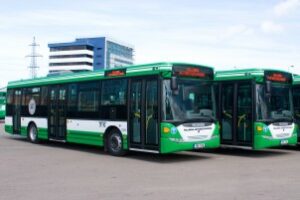
Scania K 270 UB4X2LB
A two-axle, low-floor city bus, manufactured in 2007 at the Scania bus factory in Poland. The bus features an aluminium body with a length of 11.96 m, width of 2.55 m, and height of 3.30 m. The vehicle has a total of three sets of doors, of which the entrance at the second set is stepless. Seats 31 passengers and has standing room for 57. Fitted with a DC 917 270 hp Euro 4 compliant turbodiesel engine with a capacity of 8,867 cc and a power of 198 kW, a ZF 6HP 592C NBS six-speed automatic transmission, and 275/70R22.5 tyres. Weighs 11.8 tonnes unladen.
The bus is equipped with a ‘kneeling’ function, as well as a collapsible metal ramp at the second entrance. An onboard computer monitors fuel consumption and provides fault detection. The side windows are double-glazed, tinted, glued to the body, and contain ventilation panels. The bus is equipped with an automatic compartment temperature control system and two ventilation hatches in the ceiling, the first of which is electrically operated. It also features orange Mobitec LED routes displays that are clearly legible even in bright daylight, as well as an electronic destination screen and automatic GPS-based stop announcement system. The last trip was made on November 30, 2022.
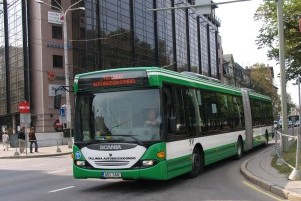
Scania CL94 UA6X2/2LB 300 Omnilink
A low-floor, four-door articulated bus, manufactured in spring 2006 at the Scania plant in Poland. These were the first low-floor articulated buses in Tallinn and Estonia – the first and second entrance are both stepless to make the bus more accessible to wheelchair users, mothers with prams, and people with reduced mobility. The second entrance is fitted with a collapsible metal ramp. The bus is equipped with a ‘kneeling’ system that allows the side to be lowered to the level of the bus stop kerb.
Dimensions: length 18 m, width 2.55 m. Carrying capacity: 140 passengers total, 40 seated. Features a 230 kW turbodiesel engine and a five-speed ZF automatic transmission. An onboard computer provides calculation and monitoring of fuel consumption and fault detection. The side and rear windows are double-glazed and tinted, side windows have openable ventilation panels. The bus has a forced ventilation system to supply fresh air and extract stale air. The body is thermally insulated, there are heating radiators connected to the engine cooling system installed by the interior walls, plus electric fans. An automatic temperature control system maintains a set temperature in the passenger compartment. As with all newer buses, a set of sensors prevents the doors from closing when obstructed, and an interlock system prevents departure while doors are open. Security cameras installed at the third and fourth entrance allow the driver to monitor what is happening inside the bus. The last trip was made on November 30, 2022.
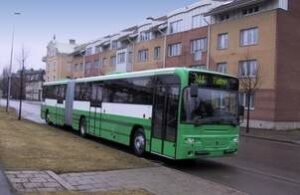
Volvo B12MA
A four-door articulated bus manufactured in Sweden with double-glazed windows and an advanced heating and ventilation system. Length: 18.0 m. Seats 36, with a total carrying capacity of 174 in the case of eight passengers per square metre of free floor space (under the development plan for Tallinn, from 2005, one square metre should accommodate seven people, making the total capacity 150 passengers). The Volvo B12MA is a tri-axle bus equipped with a fuel consumption meter and a fault detection system. The floor of the passenger compartment is roughened to prevent slipping. Fitted with a Euro 3 compliant, six-cylinder, four-stroke, turbocharged, overhead valve and direct injection diesel engine with a maximum power of 250 kW. This was the first range of Euro 3 compliant city buses in Estonia to meet strict sustainability requirements. The body of the bus can be raised when driving over an obstacle. The front can be lowered to facilitate entry. Arrived in April 2003, the last scheduled flight took place on June 11, 2021.
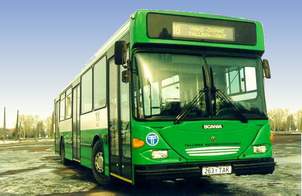
Scania Hess L94 UB City
A semi-low-floor, normal-length, three-door city bus. Manufactured in Tartu by AS Baltcoach. Length: 12.0 m. Seats 38, with a total carrying capacity of 111 in the case of eight passengers per square metre of free floor space (under the development plan for Tallinn, from 2005, one square metre should accommodate seven people). Two-axle bus with aluminium body; the exhaust gas composition and noise level meet EURO 2 requirements. Maximum engine power: 162 kW. The braking system is equipped with ABS. Features a reinforced heating system, double-glazed side windows, front door ‘kneel’ function, and a pram space. Delivered to TAK between January and February 2003.
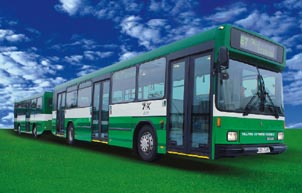
Bus train
The bus train is comprised of a Scania L94 UB bus as the tractor unit and an APM 5.2-13 bus trailer. The total length of the bus train is 23.2 m. The tractor unit and trailer both seat 29 passengers, and the total carrying capacity of the bus train with standing room is 212 people. The bus train is equipped with an environmentally friendly diesel engine, exhaust emissions and noise levels meet EURO 2 requirements.
The vehicle was manufactured in Tartu by Baltscan AS. The first bus train was introduced to Tallinn’s city routes on 18 November 1999.
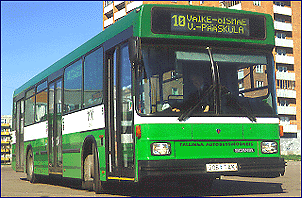
Scania Hess L94UB
A semi-low-floor, normal-length, three-door, environmentally friendly city bus. Manufactured in Tartu by Baltscan AS. Length: 12.0 m. Seats: 29. Total carrying capacity: 111 passengers. The composition of the exhaust gases and the noise level meet EURO 2 requirements. Maximum engine power: 162 kW. The braking system is equipped with ABS. The bus features a reinforced heating system, double-glazed side windows, front door ‘kneel’ function, and a pram space.
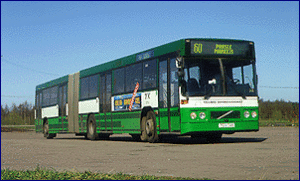
Volvo B10M
Four-door, environmentally friendly articulated bus manufactured in Sweden. Length: 18.0 m. Seats: 40. Total carrying capacity: 174 passengers. The composition of the exhaust gases and the noise level meet EURO 2 requirements. Maximum engine power: 210 kW.
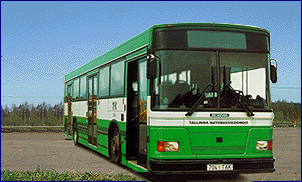
Scania L113CLB
Normal-length, three-door city bus. Manufactured in Tartu by Baltscan AS. Length: 12.0 m. Seats: 26. Total carrying capacity: 111 passengers. The composition of the exhaust gases and the noise level meet EURO 1 requirements. Maximum engine power: 172 kW.
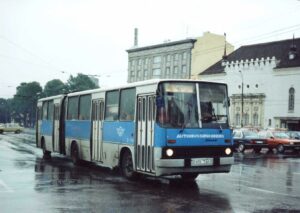
Ikarus-280
Four-door, articulated city bus manufactured in Hungary. Length: 16.5 m. Seats: 35. Total carrying capacity: 174 passengers. Maximum engine power: 142 kW. Operated by TAK from 1975 to 2003.
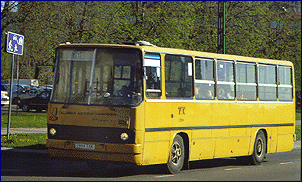
Ikarus-260
A normal-length, three-door city bus manufactured in Hungary. Length: 11 m. Seats: 22. Total carrying capacity: 111 passengers. Maximum engine power: 142 kW. Operated by TAK from 1973 to 2003.
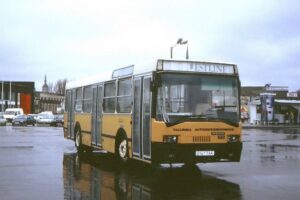
Ikarus-415, Ikarus-435
As the Tallinn Bus Company (Tallinna Autobussikoondis – TAK) was the most experienced operator of Ikarus buses in the USSR at the time, TAK was permitted to test various innovations to improve the technical aspects of the buses in collaboration with the manufacturer. In 1990, one prototype each of Ikarus-415 and Ikarus-435 were put into service. These were test units that never went into production.
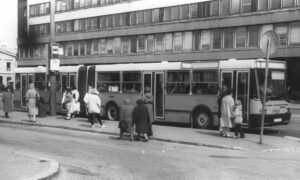
The buses had a number of technical shortcomings and had to be sold soon after. As the market of the Ikarus plant, which consisted of the entire USSR, was vast and selling off what was produced was not an issue, the technical level of the buses began to lag behind that of Western European bus manufacturers. In order to save metal, the thickness of the wall of the bus frame was reduced, and protection against corrosion was deficient. The diesel engine, manufactured under a licence from MAN, started to smoke after only a few years of use. The compartment heating system did not provide enough heat in winter. The windows were single-glazed, the floor of the bus had a poor load-bearing capacity, and there were many, many other technical problems.
The Ikarus-415 bus was used by TAK from 1990 to 2000 and the Ikarus-435 from 1990 to 1996.
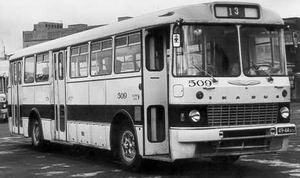
Ikarus 556
A three-door city bus manufactured in Hungary. Length: 11.0 m. Seats: 25. Total carrying capacity: 75. Maximum engine power: 132 kW. Ikarus 556 buses were introduced in the 1970s, and used from 1968 to 1979.
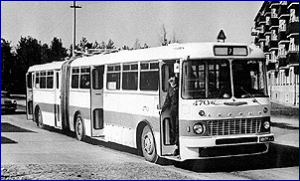
Ikarus 180
Four-door, articulated city bus manufactured in Hungary. Length: 16.5 m. Seats: 40. Total carrying capacity: 140. Maximum engine power: 132 kW. Ikarus 180 buses were used from 1967–1983. Large, white buses; the first articulated buses used in Tallinn.
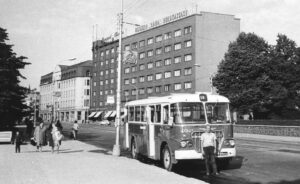
Ikarus 620
The Ikarus 620 (a modified version of the Ikarus-60) was a new type of two-door bus with a Csepel engine and pneumatic power steering. Bus drivers called them the new tractors. The roof and window section was painted white, while the rest of the bus was painted blue, red, grey, or green. Length: 9,348 mm. Csepel chassis, engine power 106 kW. The bus officially had 20 seats and standing room for 40, but actually carried up to 100 people during peak hours. Operated by TAK from 1963 to 1977.
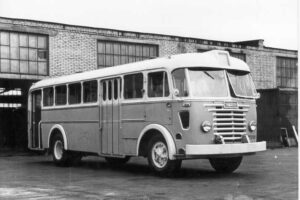
Ikarus-60
A range of shorter two-door city buses which people began calling ‘tractors’, because of the noise their engines made. These blue and dark green buses were much more economical and reliable than the Soviet ZIS and LAZ buses. The engine was located at the front, next to the driver, and the vehicles were well-suited for use in urban environments. The first Ikarus-60 buses entered use in 1957. Operated by TAK from 1957 to 1966.
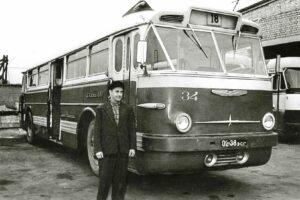
Ikarus-66
A three-door city bus with a long, streamlined body and a diesel engine. The first range of Ikarus buses used on city routes in Tallinn. The four-stroke, six-cylinder engine was located at the rear of the vehicle. Operated by TAK from 1957 to 1972.
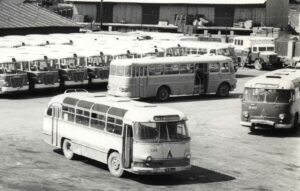
LAZ-695
Range of city buses. Operated by TAK from 1958 to 1978 (shown in the foreground in the photo).
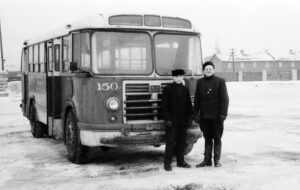
ZIS/ZIL-158
Range of city buses. Operated by TAK from 1958 to 1965.
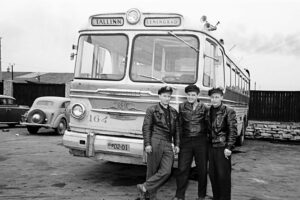
ZIS/ZIL-127
Range of long-distance buses with a two-stroke, six-cylinder diesel engine. The vehicles had one door and measured 10.2 m in length and 2.7 m in width. Despite being difficult to maneuver due to significantly exceeding established width regulations, these buses were very fast and reliable, earning them the name ‘Jets’ from drivers. Manufactured entirely in Russia, at Moscow’s Stalin Plant, which was later renamed the Likhachov Plant in 1953. Operated by TAK from 1956 to 1973.
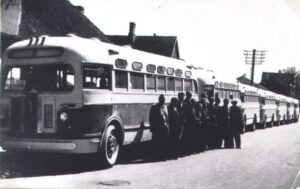
ZIS-155
The ZIS-155 was range of city buses, which the drivers nicknamed ‘Kiddo’ because of the body shape. Became predominant in the early 1950s. In 1960, the Tallinn Bus Fleet (Tallinna Autobussipark) was able to make a deal with a Leningrad-based bus company to replace the old Russian ZIS-155 buses previously in use in Tallinn with a new range of Hungarian-made Ikarus buses that had arrived in Leningrad. ZIS-155 buses were operated by TAK from 1950 to 1962.
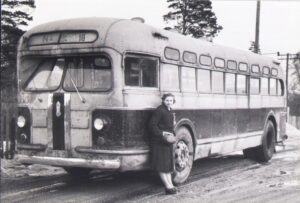
ZIS-154
Russian-made diesel-electric buses with a GMZ engine manufactured under licence from the Americans. These were progressive buses with a smoother transmission mechanism. The electric generator provided an alternating current to start the engine. The drivers called them ‘lightning bolts’. Some of the vehicles were later fitted with a Yaroslavl engine. When the licence expired, the Americans refused to renew it, ending the production of the ZIS-154 bus line. Higher carrying capacity than previous models. Operated by TAK from 1949 to 1961.
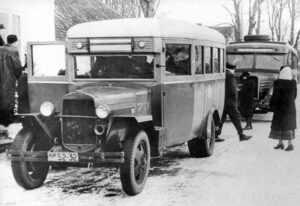
GAZ 03-30
Operated by TAK from 1946 to 1955.
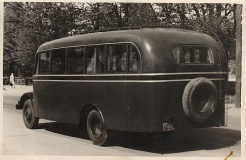
TA-1, GAZ-651
The TA-1 was a passenger transport van operated by TAK from 1951 to 1961. Body type: timber-framed wagon body. The vehicle was built on the frame of a GAZ-51 truck, which was extended by nearly 2 m to increase the carrying capacity. Seats: 23 (+ driver and conductor), total passenger carrying capacity: 28. Passengers could store their luggage on a frame mounted to the roof. Passengers entered via two doors located on the right side of the vehicle: one at the front and one behind the rear wheels. There were no doors on the left side, and the driver also entered through the passenger door.
According to A. Olander, the Tallinn Bus Fleet had a total of five TA-1 buses:
1) garage No. 95 (PP 88-53) – acquired in early or mid-1951. Drove on the Nõva route. In 1954, the bus was involved in a major accident and was decommissioned;
2) garage No. 111 (PP 90-91, later PP 91-01). Registered on 16 December 1951. Later fitted with a new TA-6 body. Used for night-time journeys and other business trips in later years. Decommissioned in 1961 or 1962;
3) garage No. 112 (PP 91-20). Registered on 16 December 1951. Later fitted with a new TA-6 body. Used in the same manner as No. 111. Decommissioned in 1962;
4) garage No. 113 (PP 91-68). Registered on 7 January 1952. In October 1952, became PP 98-83 under garage No. 113 (with GZA-651 body?). Decommissioned or transferred in 1955;
5) garage No. 118 (PP 92-58). Registered on 1 February 1952. Transferred to the 2nd Automobile Holding (Rakvere) in 1952.

